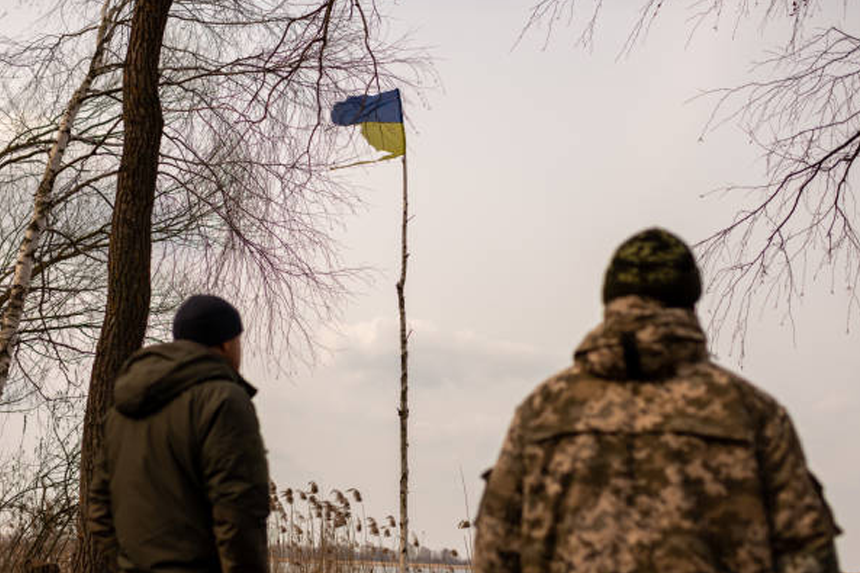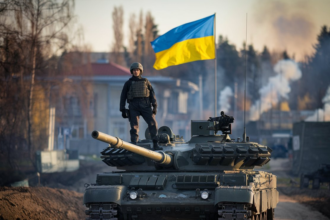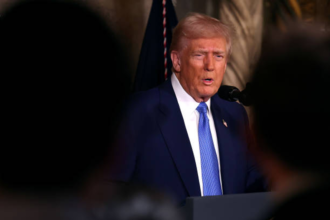Until just over a week ago, Artem Kariakin and his unit were making regular trips across Ukraine’s border into the Russian town of Sudzha. The Ukrainian forces had been conducting raids in Russia’s Kursk region, but as they retreated, the reality of war became even more apparent. Ukraine’s cross-border offensive was a bold strategy aimed at disrupting Russian forces and securing Ukraine’s border.
Artem shares a video taken on a phone, showing the chaotic final moments of their withdrawal. The footage captures them navigating past dozens of burnt-out military and civilian vehicles. A soldier armed with a shotgun—their last line of defense—scans the horizon for Russian drones. Suddenly, a drone appears and flies towards the back of their truck. Sparks fly, but the vehicle keeps moving.
“We were lucky,” Artem says. “The explosive charge wasn’t big enough to stop us.”
Not everyone was as fortunate. A nearby truck had already been engulfed in flames. Many soldiers found themselves on foot, retreating through forests and fields under constant threat from enemy fire.
Why Was the Retreat Disorganized?
Artem admits that Ukraine’s withdrawal from Sudzha, the largest town Ukraine held in the Kursk region, was “not well organized.”
“It was pretty chaotic,” he explains. “Many units left in disarray. I think the problem was that the order to withdraw came too late.”
The situation was worsened by poor communications. The Starlink satellite systems, which Ukrainian forces typically rely on, did not function inside Russian territory. Soldiers had to rely on alternative, less effective means of communication, leading to confusion and delays.
Despite the retreat, the 27-year-old soldier views the Kursk offensive as a strategic success. He argues that it forced Russia to divert forces from the east. Most Ukrainian troops managed to escape, even if many had to do so on foot.
However, Artem believes that Ukraine’s cross-border offensive was too deep and too narrow, relying on just one main road for supplies and reinforcements. The lack of alternative routes made logistics challenging, leaving Ukrainian troops vulnerable to counterattacks and supply shortages.
How Does Ukraine View Trump and Putin’s Peace Talks?
While Artem and his men were fighting for survival, U.S. President Donald Trump and Russian President Vladimir Putin were reportedly discussing ways to end the war. For Artem, the idea of these negotiations is “absurd.”
“To me, these calls between Trump and Putin are just surreal,” he says. “Trump wants to end the war because he promised to do it, and Putin wants to deceive Trump to continue his war. I can’t take their conversations seriously.”
Artem, who is originally from the now Russian-occupied Luhansk region, expresses his frustration with the U.S. and Trump’s approach.
“What can I feel when they just want to give away my home?” he asks.
He never believed that Putin would be willing to trade any part of Russia for Ukraine’s occupied territories. Still, he argues that the Kursk offensive was crucial for protecting Ukraine’s border. Though Ukrainian troops had to retreat, they still controlled high ground just over the border with Sumy, providing a strategic advantage.
Are Ukraine’s Cross-Border Raids Still Ongoing?
Despite setbacks, Ukraine is continuing its cross-border offensive, not just in Kursk but also in the Belgorod region.
Serhiy, a member of an assault battalion, plays a key role in planning these attacks. His unit identifies paths through Russian minefields and anti-tank obstacles known as “dragon’s teeth.”
“Every mission is a risk,” Serhiy explains. “We have to find the safest way through enemy defenses while avoiding drone surveillance.”
We joined him on a night-time mission to recover damaged armored vehicles. The night is the safest time to operate near the Russian border, as enemy surveillance is less intense. However, moving in darkness also presents its risks—vehicles have to navigate rough terrain with minimal visibility, and any noise could attract enemy attention.
Serhiy himself was born in Russia but now holds Belarusian citizenship. Despite his origins, he chose to fight for Ukraine. He justifies Ukraine’s incursions, pointing out that Russia has also been trying to create a buffer zone inside Ukrainian territory.
What Dangers Do Ukrainian Troops Face Near the Border?
As we travel in Serhiy’s Ukrainian-made armored vehicle, he lists the potential threats: glide bombs, rockets, artillery, and drones equipped with thermal imaging cameras. His vehicle is fitted with electronic countermeasures to jam enemy drones, but some threats remain unavoidable. Drones operated via fiber optic wires, for example, cannot be jammed. In response, Ukraine has started erecting netting along certain routes to intercept them.
“Our biggest concern is the drones,” Serhiy says. “They’re fast, silent, and deadly. Even with countermeasures, they can find ways to strike.”
Our original mission to recover a damaged U.S.-made Bradley armored vehicle is abandoned when Serhiy receives intelligence about Russian drones in the area. Instead, we attempt to locate another broken-down Bradley in a safer location.
Navigating through the battlefield remains a challenge. Trees and branches, remnants of a recent Russian air strike, block our path. In the distance, several explosions momentarily illuminate the night sky in a fiery orange glow.
Eventually, Serhiy locates the damaged Bradley. It has already been retrieved from across the border and is now loaded onto a lorry for repairs.
Is Ukraine Losing U.S. Military Support?
The Bradley commander confirms that Ukrainian forces have been actively fighting in Russian territory. He describes the conditions across the border as “difficult, but we’re holding on.”
However, the vehicle is also a stark reminder of Ukraine’s heavy dependence on U.S. military aid. With Trump’s focus shifting to peace talks, that support now seems less certain.
Serhiy believes there is political bargaining happening at Ukraine’s expense. “It’s already clear to me that there’s haggling behind Ukraine’s back,” he says.
The uncertainty over continued U.S. military aid leaves many Ukrainian soldiers feeling abandoned. Without consistent support, Ukraine’s ability to maintain its cross-border offensive is in question.
Can Europe Support Ukraine Without the U.S.?
I ask Serhiy whether a European “coalition of the willing” could fill the gap if U.S. support dwindles.
“I think if America doesn’t help Ukraine, then a ceasefire will be agreed soon—but on extremely unfavorable terms for Ukraine,” he replies.
“Europe clearly cannot resolve this conflict alone. They’re not strong enough. They’ve been focusing on their economies instead of thinking about security.”
European nations have increased military aid to Ukraine, but there are concerns over whether it will be enough. Some countries, like Poland and the Baltic states, have pledged long-term support, but others remain hesitant.
Serhiy, like many Ukrainians, longs for peace—but not at any price. “We need to fight for our land,” he says. “A forced peace that gives up our territory is not a real peace.”
As the war drags on, Ukraine’s cross-border offensive continues, but the question remains: will international support hold, or will Ukraine be forced into an unfavorable truce?








